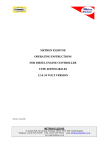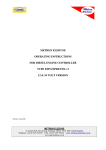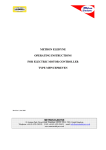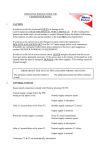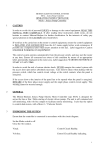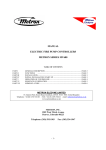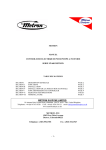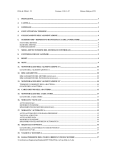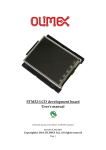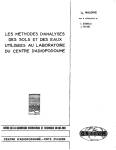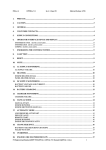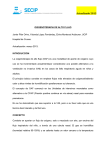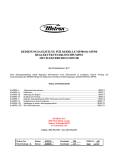Download METRON ELEDYNE OPERATING INSTRUCTIONS FOR LPC
Transcript
METRON ELEDYNE OPERATING INSTRUCTIONS FOR LPC DIESEL ENGINE CONTROLLER TYPE EFP/LPC/2000 12 & 24 VOLT VERSION Revision 4, 30 May 2007 METRON ELEDYNE 18 Autumn Park, Dysart Road, Grantham, LINCS. NG31 7DD. United Kingdom Telephone: +44 (0) 1476 516120 FAX: +44 (0) 1476 516121 email: [email protected] www.metroneledyne.co.uk OP-LPC2000 Issue 4 30-05-2007 METRON ELEDYNE OPERATING INSTRUCTIONS FOR LPC DIESEL ENGINE CONTROLLER 1. PG:- 2- CAUTION In order to avoid risk of personal INJURY or damage to the control equipment, READ THIS MANUAL VERY CAREFULLY. If after reading these instructions doubt exists, do not hesitate to contact an Metron Eledyne Engineer for further clarification. In the interests of safety pay special attention to the CAUTION notes listed below: 2. i) If work has to be carried out on the engine or control equipment, isolate the control equipment from the A.C and D.C supplies, and remove the start solenoid supplies from control circuit terminals 9 and 10 before work commences. If possible use a temporary label which draws attention to this fact. ii) Due to the nature of the equipment, the control system may start the engine at any time. Ensure all concerned are aware of this condition by means of an appropriate label, prominently displayed on the engine skid. iii) When the equipment is energised and on line, ensure all doors are closed and where applicable locked. If during commissioning the equipment is energised with the access door to the panel interior open, to avoid the risk of electric shock ensure that extra care is taken and the panel is not left unattended. TRANSPORT & STORAGE INSTRUCTIONS All of the control systems produced by Metron Eledyne are dispatched as complete units and are all protected against corrosion unless otherwise specified. When the control systems leave the factory they have been checked and packed for transportation whether it is by land or by air, the units are always packed in a very safe and secure manner. When the controller is being moved adequate care should be taken. The unit should be moved by equipment that can handle the controller=s weight and care should taken to ensure the moving equipment has not been overloaded. The controller should be moved with the appropriate lifting straps or slings, or by eye bolts if the unit has them fitted. The controller can be stored until ready for use as long as it has been placed in a vertical manner and is kept in a dry and safe environment to avoid damage to the unit. If the controller is stored for a longer period than 4 weeks arrangements must be made for the unit to contain moisture deterrents so not to damage any of the controllers electric circuits. The moisture deterrent must be removed and discarded once the unit is in full operation. MISUSE OF THIS EQUIPMENT OR MAN HANDLING MAY RESULT IN SERIOUS INJURY OR DEATH OP-LPC2000 Issue 4 30-05-2007 METRON ELEDYNE OPERATING INSTRUCTIONS FOR LPC DIESEL ENGINE CONTROLLER 3. PG:- 3- GENERAL These operating instructions are applicable to the Metron Eledyne diesel engine fire pump control panel type EFP/LPC/2000. The control system is a dual battery, fully automatic engine start system which complies generally with the requirements of the LPS standard and EN12845. This was formerly the ‘Loss Prevention Council= LPC standard. The actual difference between the EN12845 and the LPS fire pump controller standards is basically the crank sequence. LPS requires the controller to crank the engine from the selected battery, while the EN12845 standard requires the controller to crank the engine from both battery sets alternately. This difference is software selectable. Please refer to drawing DE1911 sheet 2/3 lower left corner for actual crank sequence supplied. LPC Crank Sequence The engine cranks from the selected battery during a six cycle or, if the selected battery fails, the cranking will automatically change over to the alternative battery. Each crank is factory set at 15 seconds with a 10 second interval between all cranks. EN12845 Crank Sequence The engine cranks from battery 1 for 15 seconds, rests for 10 seconds, then from battery 2 for 15 seconds followed by a rest period of 10 seconds. This sequence is repeated three times to provide a total of six crank attempts. The duty selector switch in this mode determines which battery the engine will crank from first. The front panel lamps are of the >Light Emitting Diode= type and as such are reliable in service. The volt free contact outputs facilitate remote monitoring. The controller is fitted with an independent >Emergency Start= facility. There is a >Test Start= pushbutton which must be pressed to start the engine after either a >Failed to Start= signal or when the engine has been shutdown after an >Automatic Start Operation=. DEFINITION OF TERMS USED THROUGHOUT OPERATING INSTRUCTIONS VISUAL PILOT LAMP OR METER. AUDIBLE ELECTRONIC SOUNDER. VOLT FREE REMOTE INDICATING VOLT FREE CHANGEOVER CONTACTS. STANDBY SYSTEM AWAITING AN OPERATIONAL EVENT. OP-LPC2000 Issue 4 30-05-2007 METRON ELEDYNE OPERATING INSTRUCTIONS FOR LPC DIESEL ENGINE CONTROLLER 4. PG:4 CONTROLLER OPTIONS The LPC 2000 controller is available with variety of different factory fitted features. These features are listed below:i) A.C Mains Failure Start. Starts the engine if the A.C supply fails. ii) Oil Pressure Gauge and Sender Unit. An electrical gauge unit fed by a signal from an engine mounted sender unit. iii) Water Temperature Gauge and Sender Unit. An electrical gauge unit fed by a signal from an engine mounted sender unit. iv) Engine Tacho. Monitored by the R.P.M Meter on the cabinet door with a scale of R.P.M x 100. v) Battery Voltmeter. It is a Volts x 1 scaled meter whose function is selected by means of the ‘Function Selector’ switch S5. vi) Anti-condensation Heater. A heater, thermostat and fuse fitted to the inside of the control cabinet and powered by the A.C input. vii) Pressure Switch An externally mounted pressure switch. viii) Low Oil Pressure and High Water Temperature audio/visual monitoring. Oil/water monitoring circuit using N/O sensor contacts mounted on the engine. Provides dedicated volt-free >Engine fault Remote Monitor Contacts= and individual indicators. ix) Engine Stop Pushbutton. Provides a local stop facility at the controller. NOTE: BATTERY VOLTMETER & ENGINE TACHO These options are fitted together, they form a combined function. The >Function Selector= switch enables the operator to choose the input for a dual scaled meter. The meter is scaled in Volts x 1 (0-40V) and RPM x 100 (0-4000 RPM). OP-LPC2000 Issue 4 30-05-2007 METRON ELEDYNE OPERATING INSTRUCTIONS FOR LPC DIESEL ENGINE CONTROLLER 5. PG:5 ENERGISING THE CONTROL SYSTEM Before Energising the controller all care should be made to ensure that the control system has not been damaged during shipping, if this is the case Metron Eledyne should be contacted immediately. Open the AC/DC Isolator. Ensure by reference to the circuit diagram, that the installation has been correctly carried out. Please note, Metron Eledyne recommend that a D Type circuit breaker is fitted for incoming mains supply, upstream protection. NOTE: Directly the batteries are connected, and the audible alarm will sound as well as bringing on the >DC Isolated= lamp. This condition will remain until the system has been reset after closure of the AC/DC Isolator. When energising the controller for the first time, the following steps should be performed in this sequence: 1. 2. 3. 4. 5. Check that the contacts of the start pressure switch, terminals 23 & 24 and the auxiliary autostart switch, terminals 21 & 22 are closed, otherwise fit a temporary link. Disconnect the start solenoids at terminals 9 & 10 to ensure that the engine does not accidentally start. Before attempting to start the engine during commissioning, ensure that the engine >Fuel Rack= is operable in the stopped position. Or press the controller engine stop push (Option S) to ensure that the electrical stop solenoid on the engine operates. Close the A.C/D.C isolator. Visual. D.C. Isolated - Off. Power On. Ammeters show charging current. Reset controller, the audible alarm stops. The controller is now in >Standby= status and is indicated as follows:Visual. Battery 1 Healthy Battery 2 Healthy All other lamps out Audible. Silent. Open the A.C/D.C Isolator. Replace any temporary links with the field connections. Refit the start solenoid connections to terminals 9 & 10. Close the A.C/D.C Isolator. We also recommend that the engine is first started via the manual emergency start push button to ensure that the engine run lamp operates before any automatic start is attempted. (If the engine run lamp is not functional, then the starter motor may not dis-engage on an automatic start.) The controller is now ready to be commissioned. OP-LPC2000 Issue 4 30-05-2007 METRON ELEDYNE OPERATING INSTRUCTIONS FOR LPC DIESEL ENGINE CONTROLLER PG:6 Before commissioning commences we strongly recommend that the rest of this manual be read. 6. DC SUPPLY MONITORS/BATTERY CHARGERS. FLOAT VOLTAGE & CURRENT LIMIT. The enclosure is fitted with a panel rating label which provides information regarding float voltage and current limit settings. The label is located at the top of the enclosure door. The information contained on the label must be checked against your specification and the battery manufacturer’s recommendations Two fully automatic battery chargers are fitted and factory set to produce a current limit to a maximum of 8 Amps. The exact current limit setting depends upon the ampere/hour capacity of the batteries. The current decreases to approximately 0.5 Amps at the float level. The battery float voltage level is factory set for the particular installation. If the battery voltage falls below approximately half the float level you will receive a visual indication that the battery has failed by Battery 1 Healthy or Battery 2 Healthy going out. The volt free contacts will indicate DC Supply Fault, if the charger is then enabled, charging will begin and the ammeter will read the current limit value. When the battery has been recharged to a few volts above the failure threshold, the alarms can be cancelled by pressing the >Reset= pushbutton. The charging of the battery will continue until the float level has been reached. NOTE:Maintenance of batteries should be carried out in accordance with the instructions issued by the battery manufacturer. A weekly check should be made on the state of charge and the electrolyte level, to ensure that the plates are always covered. Only pure distilled water should be used for battery topping up. BATTERY BOOST CHARGING. Consult your battery manufacturers before starting to use this facility. We recommend that battery boost only be used at the installation commissioning stage. With the power on, pressing the Boost charge push button which is located on each battery charger will cause the battery Boost to commence. Visual indication will illuminate Battery 1 Boost and/or Battery 2 Boost. The voltage will steadily rise. When the current has reduced to a minimum steady value and the voltage has risen to approximately 2 volts above the float level, the input to the battery has reached its maximum values and the boost is complete. To stop the boost the Boost push button is pressed again and the system will return to float voltage, alternatively the boost timer will reset automatically after 8 hours. OP-LPC2000 Issue 4 30-05-2007 METRON ELEDYNE OPERATING INSTRUCTIONS FOR LPC DIESEL ENGINE CONTROLLER PG:7 NOTE:Care should be taken at all times when the control system is boost charging this is due to the fact that leaving the system in boost could be dangerous. Excessive boosting of the batteries will cause them to emit hydrogen gas, which may result in damage. Ensure that the surrounding area of the batteries is well ventilated. BATTERY DISCONNECTION. If the controller is affected by a battery disconnected condition, DC supply visual indication will be by Battery 1 Healthy or Battery 2 Healthy going out. The volt free contacts will indicate a DC Supply Fault, if both of the batteries are affected by this then the controller will be blacked out. Visual. Battery 1 or 2 Healthy goes out. Volt Free. DC Supply Fault. Audible. Non - Mutable When the battery has been reconnected the >Reset= button will need to be pressed in order to bring the controller back to a standby state. CHARGER FAILURE. Should the charger stop charging for period longer than 160 seconds, the charger will sense this and instigate an AC/Charger Failure alarm. Visually AC/Charger Failure LED illuminates and the volt free contacts will indicate a DC Supply Fault. Visual. AC/Charger Failure. Volt Free. Fault on engine or controller. Audible. Non - Mutable AC FAILURE. Should there be an AC failure the battery charger will sense this and after 30 seconds instigate an AC/Charger Failure alarm. Visually AC/Charger Failure LED illuminates and the volt free contacts will indicate DC Supply Fault. Visual. AC/Charger Failure. Volt Free. Fault on engine or controller. Audible. Non - Mutable. BATTERY CHARGER LAYOUT OP-LPC2000 Issue 4 30-05-2007 METRON ELEDYNE OPERATING INSTRUCTIONS FOR LPC DIESEL ENGINE CONTROLLER PG:8 12V FLOAT, VR1 24V FLOAT, VR3 The Controller contains two battery chargers 1 & 2. The charger is of an advanced design which contains features such as :8 HOUR BOOST CHARGING VIA PB1 (Manual or Automatic Boost Reset) CHARGER FAILURE. CHARGE FROM A DEAD FLAT BATTERY, VIA PB2 VARIABLE FLOAT VOLTAGE. VARIABLE CURRENT LIMITING. Please refer to the Metron Eledyne ‘Set Up Procedure Type PC195’ for more information regarding to the set up of this module. (Available upon request.) See Appendix A, for battery safety information. OP-LPC2000 Issue 4 30-05-2007 METRON ELEDYNE OPERATING INSTRUCTIONS FOR LPC DIESEL ENGINE CONTROLLER 7. PG:9 AUTOMATIC START SEQUENCE. With the controller in standby, should the pressure drop, opening the pressure switch contacts across terminals 23 & 24 or the auxiliary autostart contacts across terminals 21 & 22 open, then the >Pump on Demand= LED will illuminate, volt free contacts will indicate >Pump on Demand= and a crank sequence will commence. Visual. Pump on Demand. Volt Free. Pump on Demand. CRANK SEQUENCE / DUTY BATTERY. EN12845 version When a crank sequence begins, the engine will be cranked by the duty battery chosen by the >Battery Duty Selector= switch. If the engine does not start immediately the crank will continue for 15 seconds, the crank sequence routine will then proceed with a 10 second dwell before repeating this crank and rest time on the other battery. This sequence will continue until either the engine starts or 6 cranks have been completed, when a failed to start alarm will occur. CRANK SEQUENCE / DUTY BATTERY. LPC / LPS version When a crank sequence begins, the engine will be cranked by the duty battery chosen by the >Battery Duty Selector= switch. If the engine does not start immediately the crank will continue for 15 seconds, the crank sequence will then proceed with a 10 second dwell followed by a further 15 second crank. This sequence will continue until either the engine starts or 6 cranks have been completed, when a failed to start alarm will occur. BATTERY FAILURE DURING CRANKING. As the starter motor engages, the battery voltage dips briefly to a low value and then recovers to a higher steady value during cranking. With a poor battery, the steady cranking voltage eventually falls below the fault level of approximately half the float voltage, this voltage drop is sensed and all remaining attempts are transferred to the other battery. This is valid for all crank sequences, LPC, LPS and EN12845. REPEAT START. If the starter engagement is not satisfactory, the starter will disengage and try again after a delay of approximately 1 second. ENGINE RUNNING. After a pump on demand signal has been received, the engine will be cranked and will normally start immediately. The engine starting will cause an engine running signal produced either by the engine speedswitch contacts closing across terminals 2 & 3 or by the electronic speed switch incorporated on the mother board, which is fed by a signal originating from a magnetic pickup mounted on the engine. OP-LPC2000 Issue 4 30-05-2007 METRON ELEDYNE OPERATING INSTRUCTIONS FOR LPC DIESEL ENGINE CONTROLLER PG:10 In both cases receiving the run signal will immediately halt the cranking, cause the >Engine Running= LED to illuminate and volt free contacts will indicate >Engine Running=. Visual. Engine Running. Pump on Demand. Volt Free. Engine Running. Pump on Demand. HOURS RUN METER. The >Hours Run meter operates whenever the >Engine Running= lamp is lit. 8 STOPPING THE ENGINE. When the >Pump On Demand= indications have cleared it is safe to stop the engine, which will cancel the engine running indications and illuminate the >Operate Test Start= LED. The engine should not be stopped when the >Pump On Demand= LED is on as the engine will restart immediately the engine running signal is lost. If, for overriding safety reasons, the engine must be stopped in the presence of a >Pump On Demand=, the AC/DC isolator must be opened and then the engine can be stopped. If option S, fuel solenoid output is fitted then: The engine can be stopped by pressing the stop push button located on the cabinet door. Once pressed, then the energize to stop solenoid output is energized for a predetermined time period. The engine will not be available to start again until this time period has elapsed. Factory pre-set to 15 seconds. 9 OPERATE TEST START. EN12845 version When the ‘Operate test Start’ LED is illuminated, it is only extinguishable by running the engine when started by pressing the ‘test start’ push button. By pressing the ‘Test Start’ pushbutton the EN12845 crank sequence will be initiated until the engine starts. 9 OPERATE TEST START. LPC / LPS version When the >Operate Test Start= LED is illuminated, it is only extinguishable by running the engine using the >Test Start= pushbutton. Operating the >Test Start= pushbutton will, crank the engine using the other battery (opposite to the battery selected ) to start the Engine, this will, when the engine running signal is received, turn off the >Operate Test Start= LED and illuminate the Engine Running LED. Stopping the engine will now return the controller to standby. OP-LPC2000 Issue 4 30-05-2007 METRON ELEDYNE OPERATING INSTRUCTIONS FOR LPC DIESEL ENGINE CONTROLLER 10 PG:11 ENGINE FAILED TO START If after 6 attempts the engine fails to start, the >Failed To Start= LED will illuminate and the volt free contacts will indicate Failed To Start. The Audible alarm will sound. Visual. Failed To Start. Volt Free. Failed To Start. Audible. Non - Mutable. If the FIRE CALL is still present ( ie pump on demand remains ) then an EMERGENCY START should be attempted. In order to reset the alarm, first ensure that the Pump On Demand has been cancelled, then operate the >Reset= pushbutton and the controller will return to standby. 11 EMERGENCY START Lift the protective plastic cover of the emergency start pushbutton by whatever means necessary. When the button is pressed the engine will crank on both batteries ensuring the best possible crank is delivered to the engine, release the pushbutton immediately the engine starts. OP-LPC2000 Issue 4 30-05-2007 METRON ELEDYNE OPERATING INSTRUCTIONS FOR LPC DIESEL ENGINE CONTROLLER PG:12 EMC (ELECTROMAGNETIC COMPATIBILITY All of the control systems supplied by Metron Eledyne have had a part or full EMC test during the controller=s proto-type stage but if required a full Pre-compliance test can be carried out. We at Metron Eledyne are able to provide facilities for full in house EMC testing which meets the Generic Standard for the industrial environment EN 50 081 and prEN 59 082-2:1992. Shown below is a list of the pre-compliance tests we are able to carry out and a list of the standards met by each test:RADIATED IMMUNITY: Immunity standard in accordance with IEC 8013:1984 as referenced from prEN 50 082-2:1992 CONDUCTED IMMUNITY: Immunity standard pre-standard ENV 50 141 RADIATED EMISSIONS: Immunity standard in accordance with EN 55 011:1991 as referenced from EN 50 811-2:1992 CONDUCTED EMISSIONS: Immunity standard in accordance with EN 55 011:1991 as referenced from EN 50 811-2:1992 ELECTRICAL FAST TRANSIENTS/ BURST INTERFERENCE: ELECTROSTATIC DISCHARGE: VOLTAGE DIP/ SHORT INTERRUPTIONS: Immunity standard in accordance with IEC 8014:1988 as referenced from prEN 50 082-2:1992 Immunity standard in accordance with IEC 8012:1991 as referenced from prEN 50 082-2:1992 Immunity standard prEN 50 093 Upon completion of testing Metron Eledyne will supply a full report which outlines the tests carried out and shows the results obtained from each test. This can be used as part of a final technical construction file (TCF). If you would like a copy of an EMC report for the LPC2000 please contact one of our engineers who will help you with this matter. You will find names and numbers on the contacts page. OP-LPC2000 Issue 4 30-05-2007 METRON ELEDYNE OPERATING INSTRUCTIONS FOR LPC DIESEL ENGINE CONTROLLER PG:13 PC206 RELAY BOARD PC198 CONFIGURATION POD TO ANNUNCIATOR RS232 CONNECTION CUSTOMERS CONNECTION POINT Care should be taken when handling the pcb due to the fact of it being a static sensitive item. The board can be damaged by all means of Electrostatic charge, which can be generated by an individual or by other electrical equipment, this is compounded if the panel is not properly earthed. The PC206 printed circuit board is at the heart of the LPC2000 unit, all of its functions are performed by the PC206 which can be specifically programmed to meet customers needs. Most options are easily added and removed using the >Configuration Pod=, this is a small printed circuit board PC189 which can be programmed to change various options and functions. OP-LPC2000 Issue 4 30-05-2007 METRON ELEDYNE OPERATING INSTRUCTIONS FOR LPC DIESEL ENGINE CONTROLLER PG:14 APPENDIX A SAVE THESE INSTRUCTIONS -THIS MANUAL SECTION CONTAINS IMPORTANT SAFETY AND OPERATING INSTRUCTIONS FOR THE METRON ELEDYNE BATTERY CHARGER TYPE. A. USE OF THE BATTERY CHARGER. The battery charger is intended for use only in Metron Eledyne control systems. Use of an attachment/connector not recommended or sold by Metron Eledyne may result in a risk of fire, electric shock or personal injury. B. REMOVING THE BATTERY CHARGER. If the battery charger should be required to be removed from the controller, to reduce the risk of damage to the electrical connections, pull the connector rather than the connecting cables. C. DO NOT DISASSEMBLE THE BATTERY CHARGER. Do not in any circumstances disassemble the battery charger, there are no user serviceable parts inside. Incorrect reassembly may result in electric shock, fire or risk of serious personal injury. D. WARNING. The performance of the battery chargers is entirely automatic. No operator variables are provided, the chargers are factory preset and NO ADJUSTMENTS MUST BE ATTEMPTED ON SITE or damage to the batteries may result. Maintenance of batteries should be carried out in accordance with the instructions issued by the battery manufacturer. E. WARNING - RISK OF EXPLOSIVE GASES Working in the vicinity of a LEAD-ACID/NI-CAD Battery is very dangerous. Batteries generate explosive gases during normal battery operation. To reduce the risk of battery explosion read the controller operating manual completely, and the battery manufacturers data. Equipment used in the vicinity of the batteries should also be carefully selected. THE LPC2000 SHOULD BE USED AS EXPLAINED IN THE ABOVE GUIDELINES OR THE WARRANTY MAY BE VOID OP-LPC2000 Issue 4 30-05-2007 METRON ELEDYNE OPERATING INSTRUCTIONS FOR LPC DIESEL ENGINE CONTROLLER PG:15 APPENDIX B. CONTACTS. For a speedier access to our personnel, Metron-Eledyne have a ISDN telephone facility which permits you to contact individuals directly. Alternatively you could call our receptionist on +44 (0)1476 516120. In addition, e-Mail facilities are available as detailed below. For direct-dial telephone +44(0)1476 516 followed by the extension numbers shown below. QUALITY BOB ABLE - QUALITY MANAGER Ext e - MAIL ADDRESS 130 [email protected] 123 [email protected] SALES AND SPARES DEAN CHILVERS – SALES MANAGER ROB McFARLANE – ENGINEERING [email protected] 124 LYNN BLACKBURN – SPARES 125 [email protected] BRUCE MURBY - TEST SUPERVISOR switchboard ENGINEERING (including field service) DAVID CARTER – MANAGING DIRECTOR 122 WAYNE RICHARDSON - DESIGN ENGINEER 129 [email protected] [email protected] Please dial our main access number +44(1476) 516120 for individuals not listed above. METRON ELEDYNE 18 Autumn Park, Dysart Road, Grantham, LINCS. NG31 7DD. United Kingdom Telephone: +44 (0) 1476 516120 FAX: +44 (0) 1476 516121 email: [email protected] www.metroneledyne.co.uk















